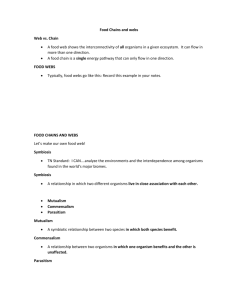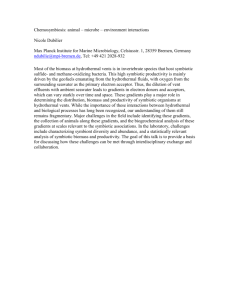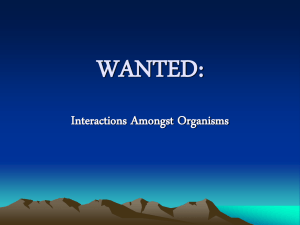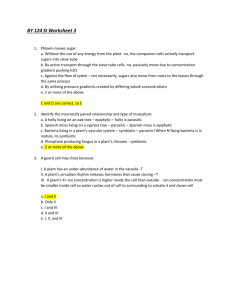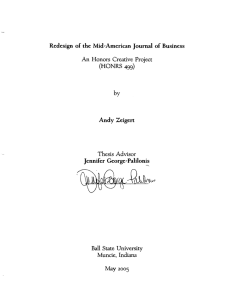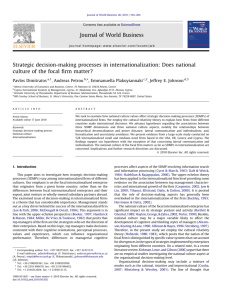Symbiotic ownership, cultural alignment, and firm performance: A
advertisement
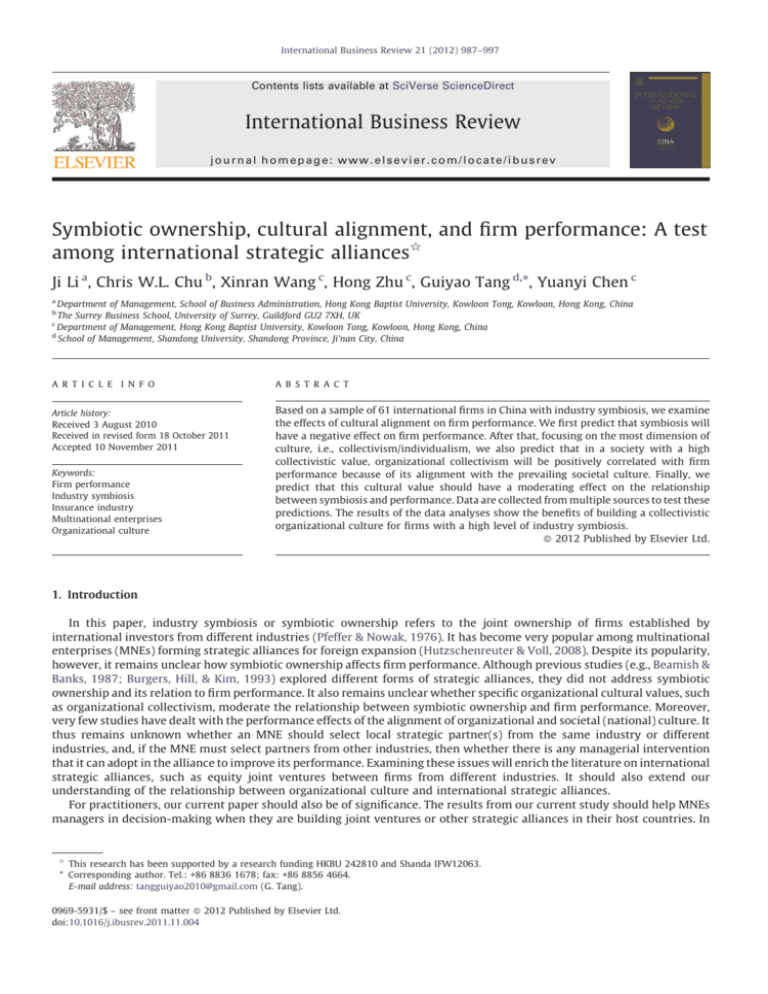
International Business Review 21 (2012) 987–997 Contents lists available at SciVerse ScienceDirect International Business Review journal homepage: www.elsevier.com/locate/ibusrev Symbiotic ownership, cultural alignment, and firm performance: A test among international strategic alliances§ Ji Li a, Chris W.L. Chu b, Xinran Wang c, Hong Zhu c, Guiyao Tang d,*, Yuanyi Chen c a Department of Management, School of Business Administration, Hong Kong Baptist University, Kowloon Tong, Kowloon, Hong Kong, China The Surrey Business School, University of Surrey, Guildford GU2 7XH, UK c Department of Management, Hong Kong Baptist University, Kowloon Tong, Kowloon, Hong Kong, China d School of Management, Shandong University, Shandong Province, Ji’nan City, China b A R T I C L E I N F O A B S T R A C T Article history: Received 3 August 2010 Received in revised form 18 October 2011 Accepted 10 November 2011 Based on a sample of 61 international firms in China with industry symbiosis, we examine the effects of cultural alignment on firm performance. We first predict that symbiosis will have a negative effect on firm performance. After that, focusing on the most dimension of culture, i.e., collectivism/individualism, we also predict that in a society with a high collectivistic value, organizational collectivism will be positively correlated with firm performance because of its alignment with the prevailing societal culture. Finally, we predict that this cultural value should have a moderating effect on the relationship between symbiosis and performance. Data are collected from multiple sources to test these predictions. The results of the data analyses show the benefits of building a collectivistic organizational culture for firms with a high level of industry symbiosis. ß 2012 Published by Elsevier Ltd. Keywords: Firm performance Industry symbiosis Insurance industry Multinational enterprises Organizational culture 1. Introduction In this paper, industry symbiosis or symbiotic ownership refers to the joint ownership of firms established by international investors from different industries (Pfeffer & Nowak, 1976). It has become very popular among multinational enterprises (MNEs) forming strategic alliances for foreign expansion (Hutzschenreuter & Voll, 2008). Despite its popularity, however, it remains unclear how symbiotic ownership affects firm performance. Although previous studies (e.g., Beamish & Banks, 1987; Burgers, Hill, & Kim, 1993) explored different forms of strategic alliances, they did not address symbiotic ownership and its relation to firm performance. It also remains unclear whether specific organizational cultural values, such as organizational collectivism, moderate the relationship between symbiotic ownership and firm performance. Moreover, very few studies have dealt with the performance effects of the alignment of organizational and societal (national) culture. It thus remains unknown whether an MNE should select local strategic partner(s) from the same industry or different industries, and, if the MNE must select partners from other industries, then whether there is any managerial intervention that it can adopt in the alliance to improve its performance. Examining these issues will enrich the literature on international strategic alliances, such as equity joint ventures between firms from different industries. It should also extend our understanding of the relationship between organizational culture and international strategic alliances. For practitioners, our current paper should also be of significance. The results from our current study should help MNEs managers in decision-making when they are building joint ventures or other strategic alliances in their host countries. In § This research has been supported by a research funding HKBU 242810 and Shanda IFW12063. * Corresponding author. Tel.: +86 8836 1678; fax: +86 8856 4664. E-mail address: tangguiyao2010@gmail.com (G. Tang). 0969-5931/$ – see front matter ß 2012 Published by Elsevier Ltd. doi:10.1016/j.ibusrev.2011.11.004 988 J. Li et al. / International Business Review 21 (2012) 987–997 other words, with better understanding of the effects of symbiotic ownership and other variables, MNEs managers should be able to make better decisions on such issues as what partners to select and what they should do to prevent potential problems. Moreover, after the joint ventures or strategic alliances were established, the findings from current study can also help them to improve the effectiveness and efficiency of the firms. Specifically, our current study is actually testing the effects of some managerial interventions, such as the building of organizational cultural value, the results from this testing should be helpful to MNEs’ managers in running their international joint ventures or other strategic alliances. In this study, we not only take into consideration the relationship between symbiotic ownership and firm performance, but also place the relationship in the context of both organizational and societal culture. We also engage in high-quality empirical research by using both data from questionnaires and panel data.1 In this way, the study makes a significant contribution to the literature on international strategic alliances. 2. Theoretical foundations 2.1. Symbiotic ownership Scholars have long recognized that ‘‘resource owners increase productivity through cooperative specialization’’ (Alchian & Demsetz, 1972, p. 777). Based on the work of Pfeffer and Nowak (1976), we defined symbiotic ownership as the mutuallybeneficial joint ownership of joint-venture firms established by international investors from different industries. As mentioned above, this type of ownership widely exists today among MNEs doing international expansion. According to the resource-dependence perspective (RDP) developed by Pfeffer and Nowak (1976), Pfeffer and Salancik (1978), business organizations establish symbiotic ownership mainly for managing their resource interdependence with other organizations. In other words, this type of ownership is used to stabilize inter-firm interdependency and reduce resources uncertainty. Consistent with the construct of symbiotic ownership, Pfeffer and Salancik (1976, 1978) have distinguished between two types of inter-firm dependence: competitive interdependence and symbiotic interdependence. The former refers to interdependence between or among partners from the same industry and the latter to interdependence between or among partners from different industries. When a firm establishes a strategic alliance with symbiotic ownership, such as an equity joint venture with firms from other industries, it is mainly in response to their symbiotic interdependence (Pfeffer & Nowak, 1976), which has been suggested by the authors to be able to help improve their performance in international markets. 2.2. The effects of symbiotic similarity on firm performance As mentioned above, Pfeffer and Nowak (1976) have suggested theoretically that symbiotic ownership should help MNEs to improve their efficiency and effectiveness in international expansion and global business, which in turn should lead to good financial performance among the international joint venture firms that have been established. In the research of international business, however, insufficient research has been conducted to test the effects of this symbiotic ownership on firm performance empirically. It remains unclear how symbiotic ownership actually influences firm performances on such dimensions as profitability and market growth. Here the main issue is that the symbiotic ownership should create more diversity among the firms, which, in turn, may increase internal and external transactional costs and affect firm performances negatively. Specifically, although symbiotic ownership may help to stabilize the resource interdependence among parent firms, as Pfeffer and Nowak (1976) have argued, this ownership may not necessarily help intra-firm efficiency and effectiveness. The reason is that symbiotic ownership should create differences in the alliance in terms of the industrial background, institutional practices, and understanding of technology of the firms involved. No past research has tested this issue empirically to provide empirical evidence of the effect of symbiotic ownership on firm performance. The work by Pfeffer and his co-authors, which reflects the perspective of RDP, have paid attention mainly to the issue of external resource control (Pfeffer & Salancik, 1976, 1978). Yet these authors consider insufficiently the internal efficiency among the joint venture firms with symbiotic ownership. To predict the effect of symbiotic ownership on firm performance, we argue that it is necessary to apply transaction-cost economics (TCE), a theory that deals with differences in internal organizational efficiency. TCE has long been applied to the study of strategic alliances. For instance, Williamson (1995), a major researcher of TCE, suggested that a strategic alliance be considered a temporary or timely form of organization, and called such alliances T-form organizations. He further pointed out that our understanding of both T-form organizations and type-three markets is insufficient, and that both require ‘‘concerted study’’ (Williamson, 1995, p. 32). An interesting related issue is how symbiotic ownership actually influences the efficiency or performance of these T-form organizations. When considering the performance of organizations, including firms in strategic alliances with symbiotic ownership, it has been suggested that economizing on internal transactions is at the heart of all reasonable predictions. As such, strategic alliances, including alliances with symbiotic ownership, should differ in performance depending on their transaction costs or operational efficiency, including the transaction costs of communication and strategic decision-making 1 Although past studies have tested the effect of collectivism on firm performance, they relied on one-source questionnaire data only (e.g., Yilmaz, Alpkan, & Ergun, 2005). As a result, their findings are not conclusive because of a possible problem with common method bias.


